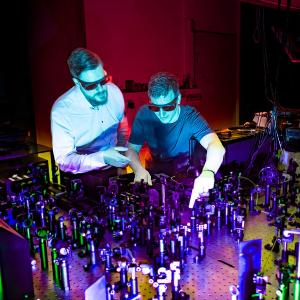Artificial neurons based on semiconductor technology
26 Jun 2023
The NEHO project is working on ultrafast neural networks, which could be used to develop more efficient methods of information processing in the future.
26 Jun 2023
The NEHO project is working on ultrafast neural networks, which could be used to develop more efficient methods of information processing in the future.

Dr. Andreas Tittl is Emmy Noether group leader at the Chair of Hybrid Nanosystems of the Nanoinstitute Munich. | © LMU
Artificial neural networks are a key technology in the domain of AI and machine learning. Many applications need the rapid parallel processing of vast amounts of data – with correspondingly high energy demand. The new EU project NEHO (Neuromorphic computing Enabled by Heavily doped semiconductor Optics), in which LMU physicist Dr. Andreas Tittl plays an important role, is seeking to develop an energy-saving alternative through a specially tailored combination of materials science and photonics. “The significance and central vision of the project consist in the realization of optical computing devices that are smaller in size, higher in efficiency, and have larger bandwidth,” explains Tittl. “In the future, these devices could establish themselves as a successful alternative to commercial chips.”
The scientists want to exploit the properties of semiconductors to create an artificial neuron that can be used to build ultrafast optical neural networks. Such photon-based optical systems, it is thought, will facilitate faster and more efficient information processing than current electron-based technologies. Furthermore, the new networks need considerably less energy.
When photons interact with matter, they generate comparatively little heat. However, the interaction is so weak that it is very difficult to control the photon flow on small scales. For this reason, the NEHO researchers will utilize the advantages of hybrid electron-photon quasiparticles – so-called plasmons. Because a plasmon carries both an electron and a photon, scientists can act on the electronic part to produce a change in its photonic counterpart. This type of interaction makes it possible in principle to control the photons on small scales.
At the heart of the project is the idea of exploiting effects that arise on the surface of semiconductors, which can be easily modulated by changing the electron density on the semiconductor surface. In this way, the researchers want to develop a platform for photonic integrated circuits. This will utilize non-linear photon-plasmon semiconductor technology to enable ultrafast and energy-efficient information processing in the mid-infrared range.
“The job of our research group at LMU is to optically characterize and then test the waveguide networks,” says Tittl. This is decisive for the future expansion and development of the project, he notes, as the networks have to be finely coordinated to control through which parts of the chip the information flows.
Supported by the EU for the next three years with funding of three million euros, the project is coordinated by the Istituto Italiano di Tecnologia (IIT) in Lecce (Italy).